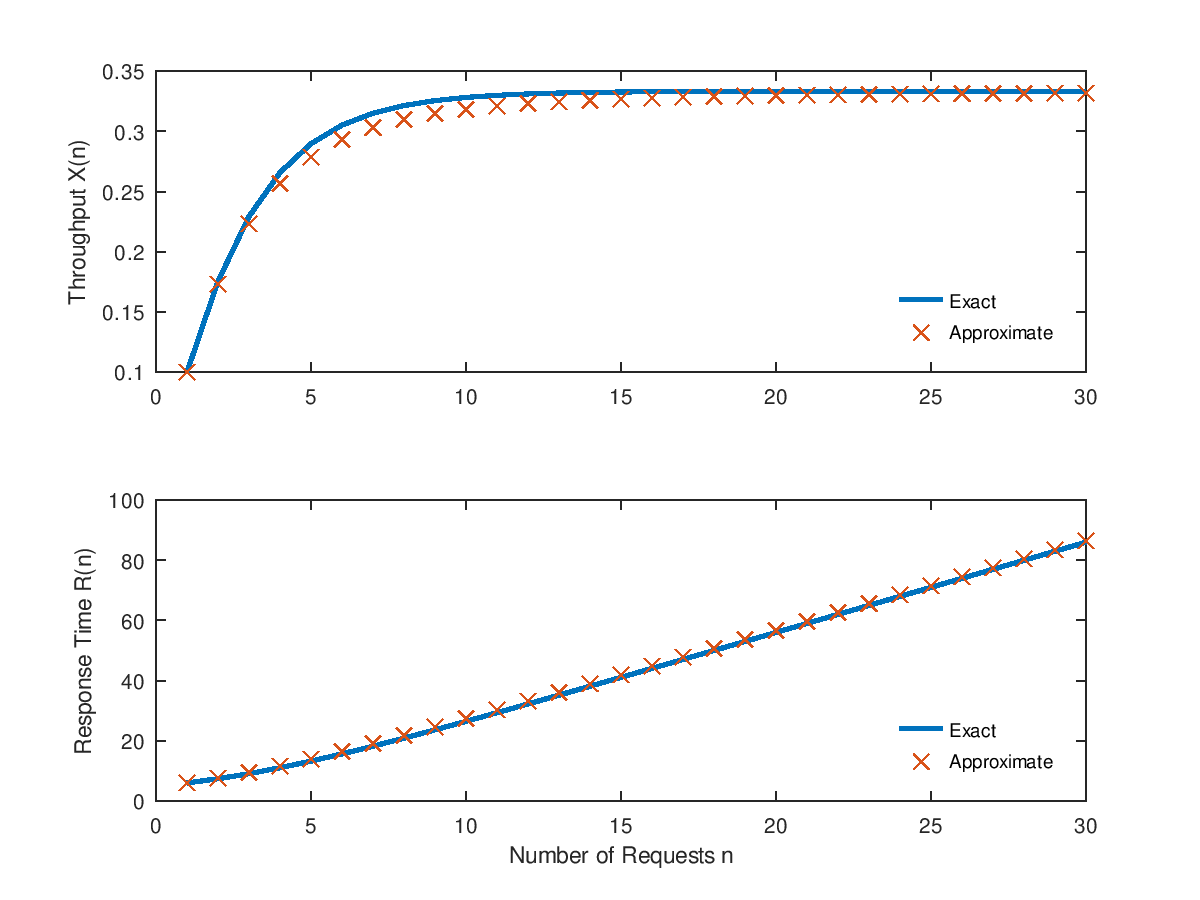- Function File: [U, R, Q, X] = qncsmvaap (N, S, V)
- Function File: [U, R, Q, X] = qncsmvaap (N, S, V, m)
- Function File: [U, R, Q, X] = qncsmvaap (N, S, V, m, Z)
- Function File: [U, R, Q, X] = qncsmvaap (N, S, V, m, Z, tol)
- Function File: [U, R, Q, X] = qncsmvaap (N, S, V, m, Z, tol, iter_max)
-
Analyze closed, single class queueing networks using the Approximate Mean Value Analysis (MVA) algorithm. This function is based on approximating the number of customers seen at center k when a new request arrives as Q_k(N) \times (N-1)/N. This function only handles single-server and delay centers; if your network contains general load-dependent service centers, use the function
qncsmvaldinstead.INPUTS
NPopulation size (number of requests in the system,
N > 0).S(k)mean service time on server k (
S(k)>0).V(k)average number of visits to service center k (
V(k) ≥ 0).m(k)number of servers at center k (if m is a scalar, all centers have that number of servers). If
m(k) < 1, center k is a delay center (IS); ifm(k) == 1, center k is a regular queueing center (FCFS, LCFS-PR or PS) with one server (default). This function does not support multiple server nodes (m(k) > 1).ZExternal delay for customers (
Z ≥ 0). Default is 0.tolStopping tolerance. The algorithm stops when the maximum relative difference between the new and old value of the queue lengths Q becomes less than the tolerance. Default is 10^{-5}.
iter_maxMaximum number of iterations (
iter_max>0. The function aborts if convergenge is not reached within the maximum number of iterations. Default is 100.
OUTPUTS
U(k)If k is a FCFS, LCFS-PR or PS node (
m(k) == 1), thenU(k)is the utilization of center k. If k is an IS node (m(k) < 1), thenU(k)is the traffic intensity defined asX(k)*S(k).R(k)response time at center k. The system response time Rsys can be computed as
Rsys = N/Xsys - ZQ(k)average number of requests at center k. The number of requests in the system can be computed either as
sum(Q), or using the formulaN-Xsys*Z.X(k)center k throughput. The system throughput Xsys can be computed as
Xsys = X(1) / V(1)
REFERENCES
This implementation is based on Edward D. Lazowska, John Zahorjan, G. Scott Graham, and Kenneth C. Sevcik, Quantitative System Performance: Computer System Analysis Using Queueing Network Models, Prentice Hall, 1984. http://www.cs.washington.edu/homes/lazowska/qsp/. In particular, see section 6.4.2.2 ("Approximate Solution Techniques").
See also: qncsmva,qncsmvald.
Demonstration 1
The following code
S = [ 0.125 0.3 0.2 ];
V = [ 16 10 5 ];
N = 30;
m = ones(1,3);
Z = 4;
Xmva = Xapp = Rmva = Rapp = zeros(1,N);
for n=1:N
[U R Q X] = qncsmva(n,S,V,m,Z);
Xmva(n) = X(1)/V(1);
Rmva(n) = dot(R,V);
[U R Q X] = qncsmvaap(n,S,V,m,Z);
Xapp(n) = X(1)/V(1);
Rapp(n) = dot(R,V);
endfor
subplot(2,1,1);
plot(1:N, Xmva, ";Exact;", "linewidth", 2, 1:N, Xapp, "x;Approximate;", "markersize", 7);
legend("location","southeast"); legend("boxoff");
ylabel("Throughput X(n)");
subplot(2,1,2);
plot(1:N, Rmva, ";Exact;", "linewidth", 2, 1:N, Rapp, "x;Approximate;", "markersize", 7);
legend("location","southeast"); legend("boxoff");
ylabel("Response Time R(n)");
xlabel("Number of Requests n");
Produces the following figure
| Figure 1 |
|---|
 |
Package: queueing